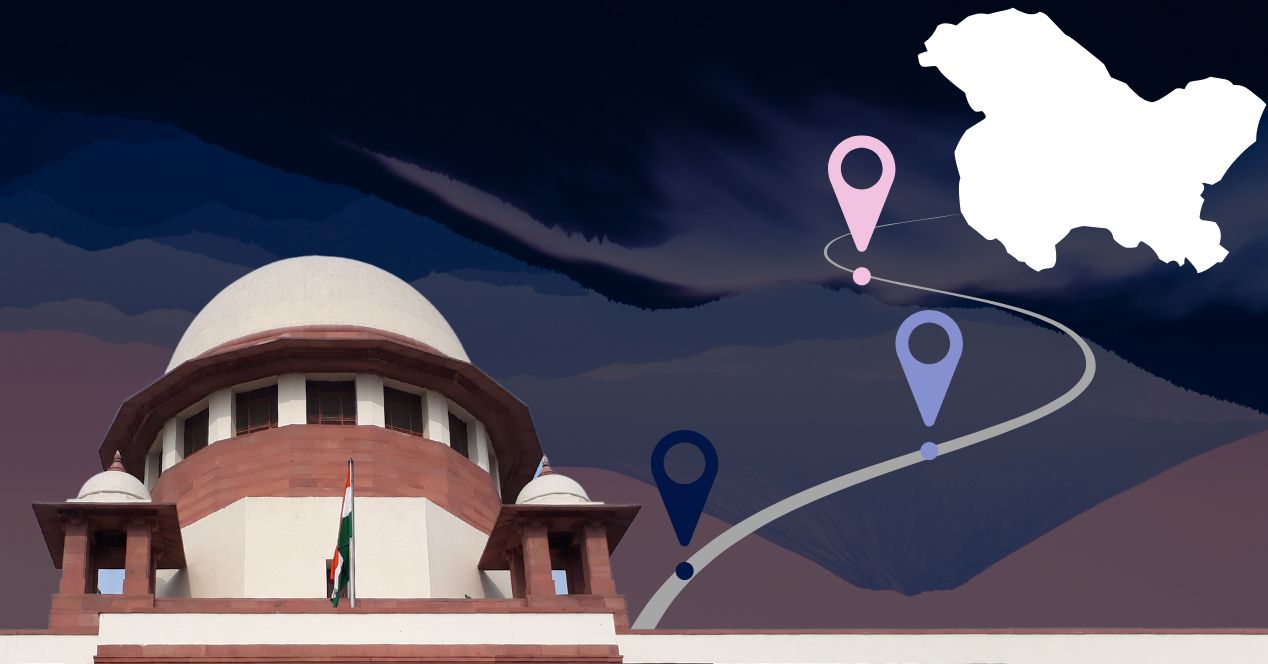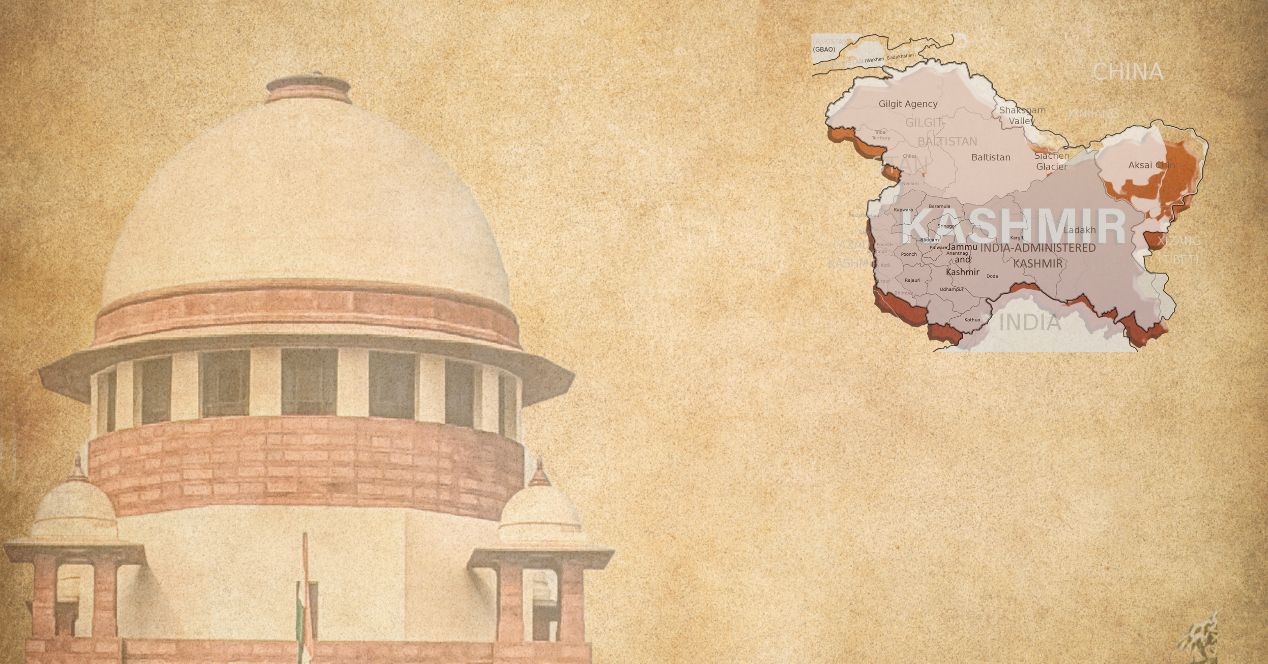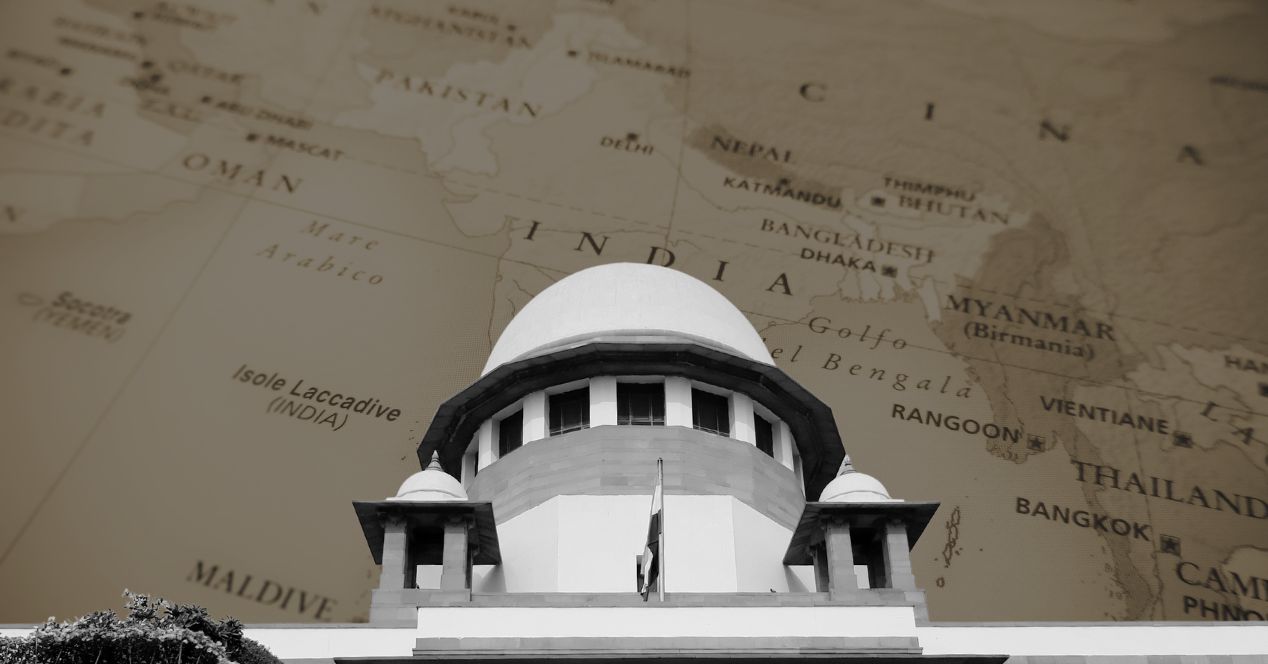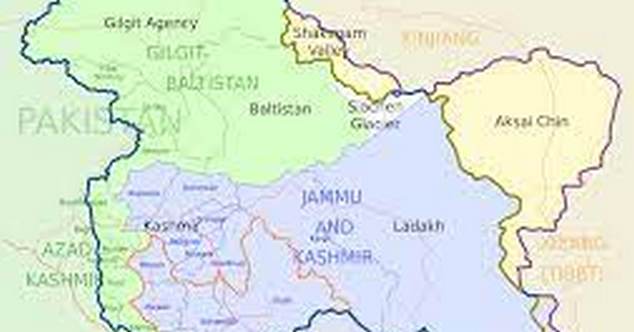Abrogation of Article 370 | Day 1: Art. 370 a Permanent Feature of the Constitution
Challenge to the Abrogation of Article 370Judges: D.Y. Chandrachud CJI, S.K. Kaul J, Sanjiv Khanna CJI, B.R. Gavai J, Surya Kant J
CJI D.Y. Chandrachud began the day’s hearings by culling out time for petitioners’ arguments. He urged them to cut down the time they have requested, and ensure there is no repetition of arguments. Petitioners agreed to only present new points, and explained that there are over 1000 pages of historical documents to get through.
At 10:40 AM on Wednesday, Senior Advocate Kapil Sibal opened the arguments for the day and sombrely said, “the hearing of this case was a historic moment as the Court will be analysing history; looking into whether the will of the people can be silenced; whether the procedure of Parliament was illegal; and whether Jammu and & Kashmir could be denied a representative form of government.”
Background
Article 370 of the Constitution of India provided the State of Jammu and Kashmir with a special constitutional status. The provision substantially limited Parliament’s power to legislate for the State compared to other states.
On August 5, 2019, the Union government diluted Article 370, revoking Jammu and Kashmir’s special status. First, President Ram Nath Kovind issued presidential order CO 272. This Order allowed the Union to amend Article 370 without the recommendation of the Constituent Assembly.
Since J&K was under President’s Rule at the time, the powers of the Jammu and Kashmir Legislative Assembly were vested in the Union Parliament. So, a few hours after CO 272 was issued, the Rajya Sabha recommended the abrogation of Article 370 through a Statutory Resolution under Article 370(3).
On August 6, 2019, President Kovind issued a Proclamation, CO 273, putting the Rajya Sabha’s recommendation into effect. All clauses of Article 370 ceased to operate, except Clause 1 which was amended to state that the Constitution of India applies wholly to the State, removing the special status awarded to Jammu and Kashmir. Article 370 was abrogated on this day.
On August 9, Parliament passed the Jammu and Kashmir Reorganisation Act, 2019. This Act bifurcated the State of Jammu and Kashmir into two Union Territories—J&K and Ladakh.
Petitions were filed challenging the constitutionality of the abrogation of Article 370 and the bifurcation of the State into two Union Territories.
On August 28, 2019, a 3-Judge Bench led by former CJI Rajan Gogoi referred the case to a 5-Judge Constitution Bench.
On October 1, 2019, 5-Judge Constitution Bench of the Court comprising Justice N.V. Ramana, S.K. Kaul, R. Subhash Reddy, B.R. Gavai and Surya Kant decided to hear the case from November 14th, 2013. The petitioners sought the case to be placed before a larger Bench. On March 2nd, 2020, the Bench refused to refer it to a larger Bench.
On July 3, 2023, the Supreme Court listed the matter to a Constitution Bench led by Chief Justice D.Y. Chandrachud. The Bench assembled on July 11, 2023 and decided to hear the challenge to abrogation of Article 370 from August 2, 2023.
History Shows that Limiting Powers of the Parliament over J&K was an Unchangeable Feature
Sibal took the Court through a list of dates beginning from pre-independent India when Kashmir became a princely state, to 1947 when its erstwhile ruler Maharaja Hari Singh acceded the State to India after partition. He argued that Kashmir was envisaged to be an independent state, but was forced to accede to India due to war.
Relying on a letter written by Maharaja Hari Singh to Lord Mountbatten written on 26 October 1947 requesting ‘immediate assistance’ from the Indian government. Sibal tried to demonstrate that the Maharaja was forced to consider acceding to India due to the Pakistani invasion of the state. Unable to ensure the security of his people, the Maharaja expressed willingness to integrate with India in exchange for India’s military protection.
Even at that stage of these deliberations, it was clear that accession came with conditions on the extent of power that the Indian Union would exercise over Jammu and Kashmir. He signed the Instrument of Accession on October 27, 1947 by which India’s power over the State would be limited to laws on defence, foreign affairs and communications. Sibal pointed out that the timeline alone indicates the Maharaja’s resistance. After India secured independence in August, devoid of options, two months later the Maharaja agreed to accede.
The Instrument of Accession Clearly Limited the Powers of the Parliament over Jammu and Kashmir
Sibal drew the Bench’s attention to sections of the Instrument of Accession signed by Maharaja Hari Singh that limited India’s power in the State. The Schedule of the IoA listed the subjects over which India could make laws for Jammu and Kashmir and specified that the residuary powers would be vested with the State of Jammu and Kashmir. This was unlike any other state, where residual powers—those that do not fall within the State or Concurrent List—would fall to the Union.
The IoA further specified that the Indian Constitution would not be applicable to Jammu and Kashmir beyond what was agreed upon. Most importantly, the IoA was clear that Article 370 could not be amended by the Parliament. It had to be done by the Jammu and Kashmir Constituent Assembly, which represented the will of the people of Kashmir.
Sibal clarified—There was no question about Jammu and Kashmir being an ‘integral’ part of India. The IoA made that clear; but the relationship was on a ‘different footing’.
Further, he argued that India’s Constituent Assembly agreed to these points listed in the IoA. A Constitutional commitment had been made on these terms, which formed the basis for Article 370 to be drafted.
Parliament Cannot Play the Role of a Constituent Assembly
Sibal argued that the extent of the Parliament’s power to legislate for Jammu and Kashmir was limited to the Instrument of Accession and the provisions of the Indian Constitution—specifically, Article 370. Forming a Constituent Assembly, and then the Constitution is a political exercise designed to ensure that the aspirations of the people it will govern is duly represented. Sibal pointed out that the Parliament, a lawmaking body, cannot replace this political exercise conducted by a Constituent Assembly, which is designed to create a framework that the people are willing to be governed by.
When a Constitution is drafted, all institutions including the Parliament, are governed by it. Parliament cannot convert itself into a Constitution Assembly through a resolution and declare itself to be the Constituent Assembly. Their powers were limited.
So, in 2019, when through a presidential order, the Union changed the meaning of the word ‘Constituent assembly’ to ‘ legislative assembly’, it exceeded this limit and took up the tasks entrusted to a Constituent Assembly. This was impermissible and contrary to the Constitution.
The Bench countered this by pointing out that Article 370 was in a part of the Constitution, ie., part XXI, which specifically deals with temporary, transitional and special provisions. As our constitution framers put Article 370 under this section, the Bench wondered if this meant that Article 370 was supposed to be a temporary provision.
The Proviso to Article 370(3) is Crucial, Article 370 Cannot be Abrogated without a ‘Constituent Assembly’
The Proviso to Article 370(3) states that ‘that the recommendation of the Constituent Assembly of the State referred to in clause (2) shall be necessary before the President issues such a notification’. The notification referred to here, is a public notification that the President may issue to declare Article 370 inoperative or modified. The Proviso imposes a condition that the abrogation of 370 can only be done with the recommendation of the Constituent Assembly.
Sibal’s arguments focused on this Proviso. He argued that Constitution framers could have stated that the President required the recommendation of Jammu and Kashmir’s legislature. Instead, they specifically stated that the recommendation of the Constituent Assembly was imperative for the abrogation of Article 370. When the Constituent Assembly dissolved in 1957, they chose not to repeal Article 370. Sibal argued that once the State’s Constituent Assembly dissolved in 1957 (after drafting the Constitution for the State), the power of abrogation dissolved with them.
This line of argument provoked a long and engaged debate between the Bench and Sibal. Justice Sanjiv Khanna asked whether the power to abrogate vanished after the constituent assembly dissolved. CJI Chandrachud stated that the Constituent Assembly is not a permanent body like the Supreme Court, thus the ‘recommendation’ of the Constituent Assembly loses its purpose once the Assembly is dissolved. CJI continued that though the condition imposed by the proviso was gone, the abrogation of Article 370 itself was not rendered impossible. The substantive part of the provision—which is that ‘the President may, by public notification, declare’ Article 370 inoperative—remained.
To this, Sibal argued that the entire history and political background behind Article 370 was rooted in making known the will of the people. This would only be achieved through the Constituent Assembly. Article 370 could not be read divorced from the proviso that mandated the approval of a Constituent Assembly, Sibal stressed, adding that such a reading of Article 370 without the Proviso would give blanket powers to the President. The abrogation of Article 370 done in 2019, Sibal stated, was not dissimilar to this process.
Sibal read out excerpts from the Constituent Assembly Debates where N. Gopalaswami Ayyangar stated that the recommendation of the Constituent Assembly was a ‘condition precedent’ for the President of India to abrogate Article 370.
Article 370 Became a Permanent Provision of the Constitution When the Constituent Assembly Dissolved
The Bench continued to stress on the point that Article 370 was not meant to be a permanent provision that nobody other than the Constituent Assembly could repeal. Chief Justice D.Y. Chandrachud took the time to elaborately discuss the framework of Part XXI of the Constitution—containing Temporary, Transitional and Special Provisions. Article 370 is nestled in this Part.
The Chief Justice sought to understand the reason that constitution framers placed Article 370 in Part XXI as a temporary provision, if it was intended to be permanent. Sibal’s counter-argument here was that the element of temporariness of this provision lasted between 1951 to 1957—when the Jammu and Kashmir Constituent Assembly was active. Constitution framers placed it there as the exercise of the Assembly was temporary. This was not to make Article 370 temporary, but to recognise that its fate was tied to a temporary body.
The day’s arguments ended at around 4:00 PM. Senior Advocate Kapil Sibal will continue to argue tomorrow (August 3, 2023).





